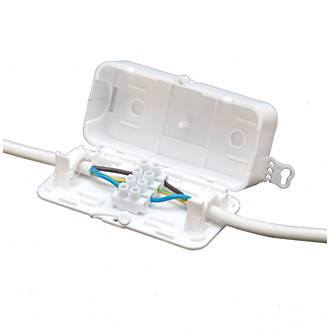Hope someone knowledgeable can help. I recently purchased a property and am in the process of changing the ceiling lights throughout the house. However I found that the kitchen downlight fitting (8 in total) are not connected to an earth (just live and neutral) and the earth wire has been cut back from the wire. All the other lights in the house have an earth.
At the light switch for the kitchen (2 switches: one for kitchen & one for rear extension) there is a fuse switch which appears to be earthed and connected to the kitchen/rear extension light switch.
As you can see there are 4 wires connected internally between the light switch and fuse switch (3 look to be coming from above and 1 from below the fitting). There is also an additional wire (unconnected to the circuit) which runs straight through (at the back of the box).

The 2 wires from the switch (kitchen & rear extension) are connected as follows. The other 2 wires connected to the fuse I don’t know where they are from??? There is also a RED wire connected from the FUSE to the SWITCH as well as another short RED wire connected from one switch connection to the other:

So my questions are:
1.) Are my kitchen lights earthed?
2.) Is this type of connection normal/safe?
3.) If I put new lights in the Kitchen (metal fitting with GU10 bulbs) will I need to earth at each light?
4.) If I need to earth each individual light, is it a simple case of putting a 3 way connector block and wiring it up? Hardly any slack on the short wire coming out of the ceiling
5.) Anything else I can do or should be aware of with this type of connection?
Thanks and hope someone can hep
At the light switch for the kitchen (2 switches: one for kitchen & one for rear extension) there is a fuse switch which appears to be earthed and connected to the kitchen/rear extension light switch.
As you can see there are 4 wires connected internally between the light switch and fuse switch (3 look to be coming from above and 1 from below the fitting). There is also an additional wire (unconnected to the circuit) which runs straight through (at the back of the box).

The 2 wires from the switch (kitchen & rear extension) are connected as follows. The other 2 wires connected to the fuse I don’t know where they are from??? There is also a RED wire connected from the FUSE to the SWITCH as well as another short RED wire connected from one switch connection to the other:

So my questions are:
1.) Are my kitchen lights earthed?
2.) Is this type of connection normal/safe?
3.) If I put new lights in the Kitchen (metal fitting with GU10 bulbs) will I need to earth at each light?
4.) If I need to earth each individual light, is it a simple case of putting a 3 way connector block and wiring it up? Hardly any slack on the short wire coming out of the ceiling
5.) Anything else I can do or should be aware of with this type of connection?
Thanks and hope someone can hep




